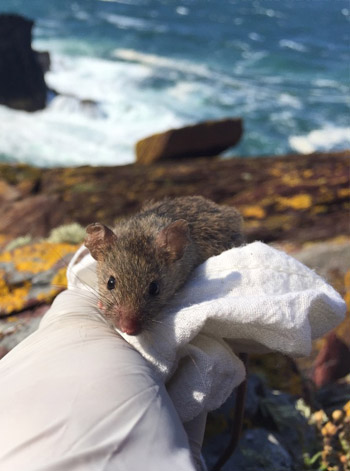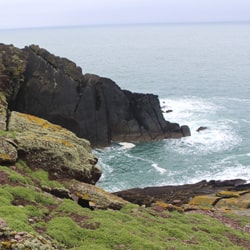
House mice on Skokholm Island
 Skokholm provides a natural laboratory
Skokholm provides a natural laboratory
Skokholm is a small but stunning island, lying just a few miles off the Pembrokeshire coast in Wales. Before the second world war, this ‘Dream Island’ was home to Ronald Lockley, a pioneering ornithologist who lived and researched on Skokholm for many years, with the island and its wildlife providing endless inspiration for his many well-known books.
Today, Skokholm is a nature reserve, with two wardens (Richard and Giselle) resident in all but the coldest winter months, and volunteers and researchers visiting regularly throughout the warmer month to study birds and enjoy the wildlife, scenery and seclusion.
Though the island is well-known for its seabirds and Observatory, the island also plays home to a large population of house mice (Mus musculus), thought to have colonised the island in the late 1890s. Unlike mainland house mice which are ‘commensal’ (living in close association with humans), mice on Skokholm have reverted to a more independent life, with many living on the cliffs, rocky outcrops and in the old drystone walls which cross-cross the island.

The views on Skokholm are spectacular
House mice are well-established as the major mammalian model species in laboratory-based research – ‘lab mice’ are house mice. Despite the vast array of knowledge and tools available for this species, detailed studies of house mice in the wild are usually complicated by their commensal lifestyle. Commensal populations are often ephemeral and heavily influenced by anthropogenic influences like pest control, making it hard to track individuals over time and understand the drivers of fitness and population dynamics. In this respect, Skokholm provides an ideal natural laboratory for studying house mice. The population is spatially well-defined (by cliffs!), and selection pressures are likely to be comparatively simple, with no resident predators on the island and no other small mammal species to compete with. Indeed, it is this attraction of a tractable island population that drew RJ Berry and colleagues to undertake intensive studies on the Skokholm mice in the 1960s and 1970s, providing a wealth of historical information on their ecology and evolution.
In early 2019, we re-established a longitudinal study of the Skokholm mouse population, with a new focus on symbiont ecology. Funded by the ERC, our goal is to use this tractable system to unpick the drivers and consequences of naturally occurring variation in the gut microbiome. Our research aims to ask how natural variation in the microbiome affects host phenotypes, and whether this really matters, in the ultimate currency of host fitness.

